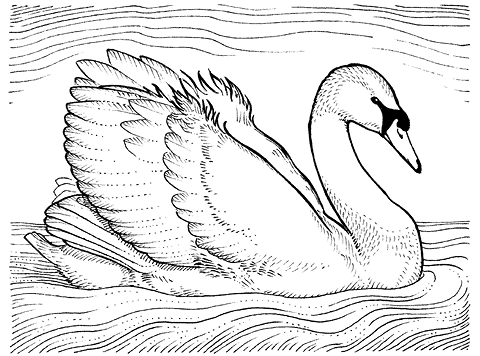Mute Swan, Trumpeter Swan, Tundra Swan
Around the world and throughout time, the swan has been considered a bird of extreme beauty, spirituality, and power. The mute swan can be distinguished from other species by the way it holds its neck in a graceful curve; other swans hold their necks up straight. Romantic as it is, the myth that the mute swan only finds its voice just before death is not true. Although it is not as vocal as other swans, it does make noise throughout its life. The trumpeter swan was so named because of its resounding calls.
Legends of swan maidens can be found from the Babylonians and the Egyptians to the Norse and the Celts. Swans were almost universally believed to shape-shift into human form. Celtic lore sometimes portrayed them as fairies in disguise. Swans figured largely in the stories of Llyr, Angus, and many other Celtic gods. In Norse myth, swans embodied the Valkyries, who were regarded as symbols of beauty and mystery, and their feathers were considered magical. They could also shape-shift into ravens. Shamans in various traditions were said to wear cloaks of swan feathers.
Swans were believed to move between the physical and spiritual worlds, and were closely associated with the soul. In many cultures, the swan was associated with music, poetry, and love. In Finnish myth, a swan singing a haunting melody circled the island of the dead. Although associated with death and the otherworld, the swan also embodied the solar principle of light and fecundity. On Scotland’s Hebrides islands, to hear a swan on Friday means good luck.
The genus name Cygnus is Latin, meaning “swan.” Male swans are called cobs, females are called pens, and baby swans are cygnets.156
Magical Workings
The otherworldly beauty of swan has linked it with death and the afterlife. It can help you find a connection with those you love who have passed beyond the veil. Swan is also instrumental for understanding the symbolism of dreams and remembering past lives. Long associated with shamanic work, this bird can guide you through other realms and support your vision quests. Swan aids divination as well as interpreting messages and omens. It can also help build your clairvoyant skills.
Closely aligned with spirituality, swan can light the way to show where your path lies. It can help you awaken to your power and cultivate intuition. Call on swan to boost love spells and to break enchantments. With its help, you can foster change and manifest what you desire. A bird of transformation, swan provides support during life’s transitions. Place an image of swan on your Imbolc and Mabon altars to symbolize these seasonal changes.
Make Connection
To connect with swan energy, visualize one moving majestically across a still pond. Having transformed from an ugly duckling, its enigmatic beauty fosters enchantment and mystery. Knowing that beauty is only skin deep, swan holds grace, love, and compassion in high regard. Keep your heart open and your intentions selfless to invite swan’s contact, which will bring a deep, meaningful sense of love.
From June to October the Cygnus constellation is easily visible in the northern hemisphere. The brightest stars in this constellation form a cross shape. About an hour after sunset, look straight up to the brightest star overhead. That star marks the tail of the swan; the lower part of the cross is its long neck and head. Visualize the swan and then close your eyes to feel the peace and power of this great bird.
Associations
Zodiac: Libra, Pisces
Element(s): Air, earth, water
Sabbat(s): Imbolc, Mabon, Samhain
Goddesses: Aphrodite, Brigid, the Muses, Nemesis, Sarasvati, Venus
Gods: Angus, Apollo, Brahma, Cú Chulainn, Lir/Llyr, Midir, Njord, Zeus
Solar system: Sun, Venus
Ogham: Eadha, Gort
Magical beings: Elves, fairies
Bird Identification
Mute Swan (Cygnus olor)
Also known as: Domestic swan, wild swan
Size: 50 to 60 inches
Wingspan: 82 to 94 inches
Comparative size: Very large
Description: All-white body and wings; orange bill with black knob at base; legs and feet range from black to grayish-pink
Range: Small areas from the Mid-Atlantic states through the Midwest
Habitat: Ponds, rivers, bogs, coastal lagoons, and bays
Eggs: Blue-green when first laid, turning white, and then brown with staining
Trumpeter Swan (Cygnus buccinator)
Size: 54 to 62 inches
Wingspan: 75 to 80 inches
Comparative size: Very large
Description: All-white body and wings; long, straight neck; black bill and face; black legs and feet
Range: Small areas of southern Alaska, British Columbia, Alberta, Oregon, Idaho, Montana, and Wyoming
Habitat: Marshes, lakes, or rivers with dense vegetation
Eggs: Creamy white
Tundra Swan (Cygnus columbianus)
Also known as: Whistling swan
Size: 47 to 58 inches
Wingspan: 66 inches
Comparative size: Very large
Description: All-white body and wings; black bill, usually with yellow patch in front of each eye; black legs and feet
Range: Arctic coasts of Alaska and Canada, along corridors to the Mid-Atlantic coast and the West Coast; occasionally on the Great Lakes
Habitat: Tundra, marshy lakes, and bays
Eggs: Creamy white
Collective noun(s): A bevy, a lamentation, a regatta, or a wedge of swans
156. Wells, 100 Birds and How They Got Their Names, 242.
